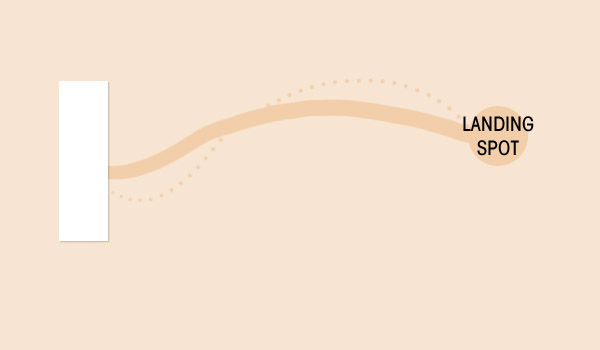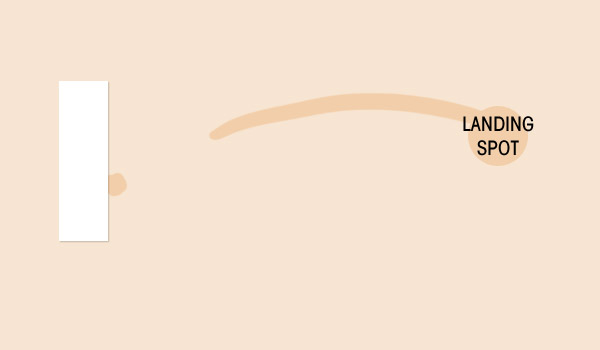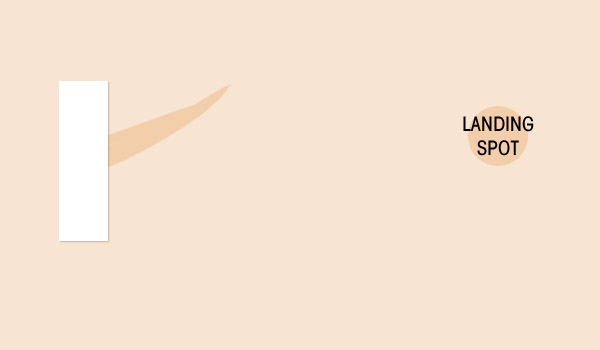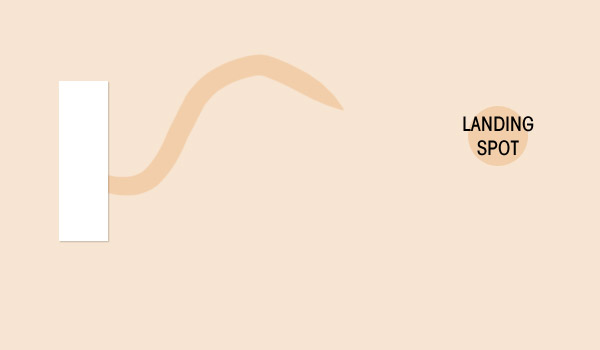Drive Through Diagrams
Every single one of you pitchers has a great training tool that you may not realize you have: the dirt below your feet! You can gather a lot of information about your pitching mechanics by looking at the markings your feet leave in the ground. Today we’ll examine some common patterns and discuss what they mean.
The following patterns are just some of the most common. Your markings may look a little different, but hopefully this series will be helpful to most of you. Also, we’re talking about fastballs here (change-ups should look the same). Certain other pitches may show some additional variation, and that’s OK.
A good drive-through pattern
Things I look for in a drive-through pattern:
- Even or mostly even pressure from start to finish
- Full connection from the pitching rubber to the landing spot
- A roughly banana-shaped curve toward the left side of the pitching rubber for righties (right side for lefties)

Some variation in the amount of curve is perfectly OK, as long as the pressure is relatively even all the way up to the front, and you stay within the width of the rubber. Traveling outside the pitching lane with your feet is illegal.
Some change in direction at the beginning is also good; that’s what happens when you get a strong forward push BEFORE opening into tracked position, as opposed to turning your body sideways too soon.
Problem patterns

Gaps in your drive line indicate a crow hop. Even an inch gap is still a crow hop, still illegal, and still detrimental to your speed and command. If you can’t close that gap, it usually means you can’t keep your knee driving toward your target. The hop happens when your foot starts out in a good position and then comes up to reposition itself onto its side. Try to aim your shoelaces toward your catcher as much as you can and leave your big toe grazing the ground.

Markings that shoot off in one direction without curving and never make it to the landing spot usually indicate poor foot and knee alignment during the drive-through. Typically in these patterns, the knee points to the side and the heel leads the drive-through. This brings the drive leg well behind the landing leg, instead of up next to it. It is usually accompanied by leaning toward the pitching hand side to balance out the leg reaching in the opposite direction, and can negatively affect accuracy as well as put unnecessary stress on the back and groin.

Patterns that curve too steeply outside the pitching lane and never make it to the landing spot indicate that your drive leg isn’t really working at all, but rather being pulled by your hips. Stand sideways with your feet apart like you just landed in a pitch. Drive your leg up to the front foot in a straight line without moving anything else. Now let your drive leg relax and pull your hip around to face forward as fast as you can. Notice how the drive foot gets dragged along about halfway and makes a squiggly shape. That’s what this is. Not using your leg to drive takes away power, and relying on your hip usually pulls your body out of alignment before the ball leaves your hand.
If your pattern doesn’t fall into one of these categories, feel free to send us a picture! We might be able to offer a recommendation.
carly,
this is great stuff. i have a question about the drive thru. when the stride foot is airborne, the pivot (pushoff) foot should remain in contact with the ground to remain legal.
however, once the stride foot lands, does the pivot food need to remain in contact throughout the drive or can/should it leave the ground and drive straight? (it’s still legal since the stride foot is now on the ground).
tnx
Awesome question. It CAN leave the ground after the stride foot lands and a lot of pitchers pitch that way. However, I do not advocate that in pitchers who are still learning. It takes more leg and core strength to maintain good posture while standing only on one leg, and for girls who don’t have that strength yet picking the drive foot up makes it easier for the mechanics to break down. I think it’s better to keep the drive leg on the ground as long as possible to make maintaining posture easier.
carly,
thanks for that explanation on core and leg strength. one question on core/leg strength. my daughter starts out her pitch with good vertical stacking, but during the delivery, she has a tendency to lean/bend at the waist towards her pitching side as opposed to standing tall. is that a core strength issue as well or just a remnant from old/bad mechanics?
tnx
It could be both. More core strength will help no matter what but if she’s been doing it for a long time she will probably also have to break the habit even if she gets stronger.
thanks!
I have a pitcher who finishes with her drive foot side by side with her stride foot. And other times finishes with her head over stride toe. These are on fast ball pitches which all ways come in low. I have tried to slow her wind up down and it seems to help what other things could be happening and how do I help her?
Hi Tony, I’m having a hard time imagining what you’re describing. Based on your description it doesn’t sound like anything is wrong, but obviously that’s not the case… do you have a photo of her finish that you could show me?
Sorry for the confusion, I looked back over Monica Abbot video on the drive and I saw when she is at finish she is still pretty close to strait up and down head just behind toes and knee and drive foot is behind stride foot. My pitchers head is out over toe and she falls off to the right bring her drive foot along side of the stride leg. wi
Ah, so she’s falling off to the right and catching herself by taking a step? If that’s the case, take some video of her and check her posture when she lands. Make sure she is in a pretty natural posture, not leaning, and not lunging. You can have her pitch next to a wall or fence to help keep her in line.
My daughter is a 1st year 12U pitcher who is very strong and pitches well. Her hips don’t open as much as they should. This is leading to loss of speed and her coming around her hip. Could you recommend some drills for this?
Hi Monique, absolute best drill for this is the wall drill: https://www.fastpitchpower.com/wall-drills-for-improved-pitching-mechanics/